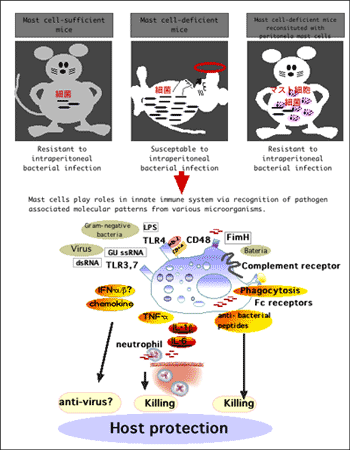 Mast cells play a detrimental role in IgE-dependent allergic reactions by releasing histamine, leukotrienes and cytokines. But the precise contributions of mast cells to biological processes not involving IgE are obscure. Toll-like receptors (TLRs) play critical role in innate immune responses by recognizing invading microbial pathogens and by activating innate immune cells. We found that mast cells also expressed TLRs and were activated by microbial pathogens via TLRs. Actually in vivo significance of mast cells in bacterial infections (a model of acute septic peritonitis) has been reported using congenitally mast-cell-deficient W/Wv mice. Following bacterial infection, W/Wv mice showed a significantly increased mortality compared to +/+ mice. We demonstrated that selective reconstitution of W/Wv mice with cultured +/+ mast cells, but not with TLR4-deficient mast cells, substantially protected them from the lethal effects of bacterial infections in a model of acute septic peritonitis. The other findings that activation of mast cells via TLR2 upon stimulation with peptidoglycan from gram-positive bacteria (Staphylococcus aureus) exaggerated skin inflammation, suggested that TLR-mediated activations of mast cells in vivo play important roles for the both innate and allergic immune responses. We are trying to figure out the mechanisms of allergy in terms of mast cell activations by revealing the previously unrecognized role of mast cells through TLR and other receptor.
Mast cells play a detrimental role in IgE-dependent allergic reactions by releasing histamine, leukotrienes and cytokines. But the precise contributions of mast cells to biological processes not involving IgE are obscure. Toll-like receptors (TLRs) play critical role in innate immune responses by recognizing invading microbial pathogens and by activating innate immune cells. We found that mast cells also expressed TLRs and were activated by microbial pathogens via TLRs. Actually in vivo significance of mast cells in bacterial infections (a model of acute septic peritonitis) has been reported using congenitally mast-cell-deficient W/Wv mice. Following bacterial infection, W/Wv mice showed a significantly increased mortality compared to +/+ mice. We demonstrated that selective reconstitution of W/Wv mice with cultured +/+ mast cells, but not with TLR4-deficient mast cells, substantially protected them from the lethal effects of bacterial infections in a model of acute septic peritonitis. The other findings that activation of mast cells via TLR2 upon stimulation with peptidoglycan from gram-positive bacteria (Staphylococcus aureus) exaggerated skin inflammation, suggested that TLR-mediated activations of mast cells in vivo play important roles for the both innate and allergic immune responses. We are trying to figure out the mechanisms of allergy in terms of mast cell activations by revealing the previously unrecognized role of mast cells through TLR and other receptor.
(Hiroko Ushio, Aug. 26, 2005)
|